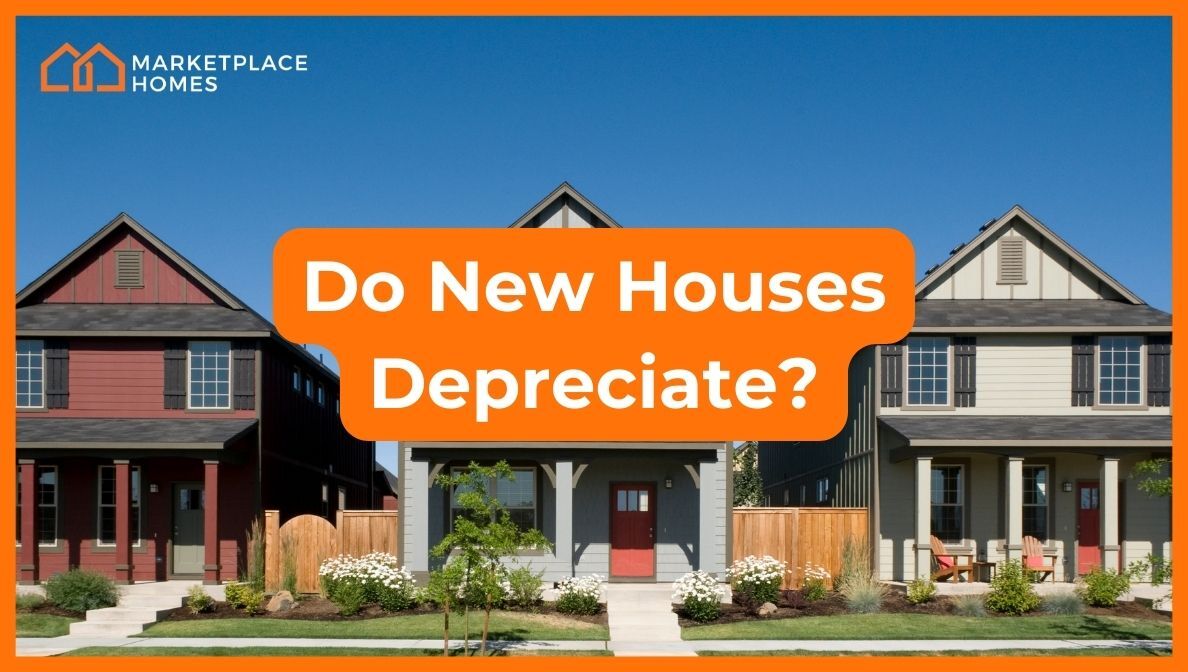Do New Homes Depreciate?
A new construction home starts at its highest property value. However, the clock immediately starts ticking on losing its value. Before you worry, understand that every home depreciates, whether they are older homes or brand-new homes. Also, real estate depreciates much slower than other personal property, like a new car, which can lose up to 20% of its total value in the first year. (Talk about ouch!)
It’s important to note that depreciation is just one factor that influences a home’s selling price. To counteract the effects of depreciation, homeowners can improve the property’s market value by maintaining and improving it. Therefore, whether you are concerned about the home you live in or a rental property, a fair amount of your house’s value is under your control.
So, what are the relevant details about depreciation, and how can homebuyers use it to make informed financial decisions regarding repairs and maintenance?
-
Disclaimer: This blog is for informational purposes only but not a complete guide. Please consult a tax professional for the most accurate and up-to-date information regarding taxes and home depreciation, especially if you’re into real estate investing.
What is Home Depreciation?
Home depreciation is the rate at which your investment property or primary residence loses value over time due to wear and tear, aging, or other factors. Being aware of home depreciation is vital for personal finances— whether you are a single-family homeowner or an investor with an extensive portfolio.
By knowing how much a brand-new property depreciates per year, homeowner and real estate investors can make strategic improvements and time a sale right. You can even reap some tax benefits when you sell, such as not being responsible for capital gains tax under certain conditions.
Types of Home Depreciation: How It Works
There are two different ways to look at depreciation. The first regards the house’s overall physical depreciation, and the second is through the lens of the IRS “straight line” depreciation model.
1. Physical Depreciation Method
Physical depreciation is directly related to the house’s wear and tear, which naturally happens from everyday use. If the house contains obsolete technology, like outdated electric and plumbing systems, this also contributes to the house’s value decline. Thankfully, you can counter many physical depreciation factors by making strategic improvements over time.
Different studies uncovered various rates of physical depreciation per year, which average to around 1%-1.2% per year, assuming proper maintenance. Newer houses tend to depreciate less quickly than older homes, but the rate of around 1% is fairly standard for homes of all ages.
2. Tax Depreciation Method
When it comes to taxes, the IRS allows you to claim home depreciation at a different rate. Your new home’s value, according to the IRS, depreciates at a standard “straight-line” rate over 27.5 years, or 3.636% per year. This doesn’t mean that the house totally loses all value after that time, but it means that you can’t claim any more tax depreciation on your home after that time period is up.
Also, home depreciation and appreciation determine the property taxes you pay, which affects mortgage payments. Overall, your taxes decrease as your home depreciates. Maintaining your home and scheduling periodic updates will prevent excessive depreciation amounts.
Your tax pro should calculate your home’s depreciation rate using figures like the cost of your home, its estimated useful life, and any improvements or renovations made. When used correctly, you can get beneficial tax breaks like claiming depreciation of home office use.
How Depreciation Happens
-
Not maintaining your home
-
Market depreciation
1. Not Maintaining Your Home
If you do nothing to your home, it will depreciate at the standard rate. Over time, technology and construction methods become outdated. Lack of maintenance means that the roofing, plumbing, and other components gradually lose value and efficacy.
If you do not ever improve your home, your home will depreciate at the quickest rate. However, there are ways to maintain your house’s value and marketability. In fact, you can see plenty of historic homes still standing today that have excellent market value.
2. Market Depreciation
Another factor to consider that directly affects the house’s physical depreciation is its location. If the local market declines, then the property’s value also declines. For the most part, this factor is out of your control and part of a general depreciation system of the area.
You can protect yourself by living in a community with a homeowner’s association that ensures that residents within the community keep up with their homes to ensure higher resale values compared to unmaintained homes.
How to Counter Depreciation
To slow down or even reverse annual depreciation, homeowners can make strategic improvements such as updating the HVAC, replacing a roof, updating the electric or plumbing system, making kitchen and bathroom upgrades, and other high ROI renovations. You may also sell your home and recover losses through the usually elevated purchase price of a home you have held on to for a while.
1. Make strategic improvements.
For instance, if you have a residential rental property that has outdated electric wiring and oil-based heating, you can improve these before resale. Not only will the house be more energy efficient and safe, but you will fight rental property depreciation and potentially increase your rental income through increased value.
Replacing outmoded or dangerous building materials like asbestos siding and lead-based paint with modern materials will also bring the house back to code.
You can even update the house’s floor plan. For example, many old homes used to have just one bathroom, but by adding another bathroom and expanding the house’s living space, you can make it more modern and get a higher house price when it’s time to sell.
2. Claim a depreciation deduction during tax time.
Tax deductions can be a great help with countering the effects of depreciation. These will reduce the amount of your taxable income on your tax return if you choose to itemize instead of use the standard deduction.
Depreciation serves as a yearly deduction on income taxes, enabling you to regain the expense or initial value of particular property over its lifespan. It accounts for the property’s natural wear and tear, deterioration, or eventual obsolescence. For more information, consult the IRS’s resource on depreciation.
3. Get depreciation recapture after selling.
Depreciation recapture refers to the profit obtained from selling depreciable capital property, which is treated as ordinary income for tax purposes. It comes into play when the selling price of an asset surpasses its tax basis or adjusted cost basis.
The excess amount between these values is then “recaptured” and reported as ordinary income. For more details, please consult Publication 544 Sales and Other Dispositions of Assets,” pages 2-3, 26-33, 36.
Invest with Marketplace Homes
If you are interested in building a rental portfolio, our real estate experts are ready to help you get started. We can also help you find your dream new construction home!
Alicia Persson is a Content Strategist SEO writer at Marketplace Homes, utilizing previous years of experience on real estate teams that specialized in investments and property management. Before she joined Marketplace Homes, she was also a freelance writer for 7 years, leading to a specialization in real estate and home living content for boutique digital marketing agencies. During her writing years, she learned the basics of SEO and gained experience writing for many different clients, making her versatile at creating diverse content.
She is a proud University of Virginia master’s graduate and enjoyed her undergraduate years at the University of Mary Washington. When Alicia is not writing, she plays keytar and sings in a local 90’s rock cover band, or she spends time with her amazing family.


